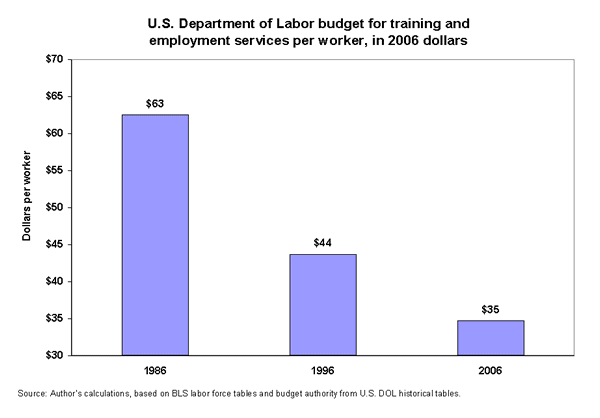See Snapshots Archive.
Snapshot for December 6, 2006.
Federal support for employment and training services dwindles
Most policy makers agree that workforce training is essential to America’s competitiveness. Job training is especially important for the 70% of the workforce without a college education, for whom it is often the key to a better job or any job at all. Yet federal support for these activities has been falling for years.
The U.S. Department of Labor (DOL) is the primary source of federal support for job training and employment services. Its block grants enable the states to pay local agencies for classroom and on-the-job training, and to help place workers in better jobs. The importance of these services is widely acknowledged. Yet, as the Figure below shows, the federal government’s commitment to training and employment assistance has been on the wane—with DOL expenditures falling from $6.1 billion in 1986, to $5.8 billion in 1996, and to $5.2 billion in 2006.

Thus, over a period when the economy grew by almost 80% and real spending by the federal government rose 62%, spending on a service that is supposedly highly valued fell by 15%. Moreover, because the labor force grew by almost 30% from 1986 to 2006, DOL spending on training and employment services fell even more dramatically in per capita terms, from $63 per worker in 1986 to only $35 per worker in 2006.
Finally, the diminishing commitment of the government to training and employment services for America’s workforce can be seen in the steep decline in DOL spending as a share of total federal government domestic discretionary spending. In 1986, DOL’s training and employment services budget was 2.27% of all domestic discretionary spending ($3.34 billion out of $147 billion total outlays). It fell to 1.81% in 1996 ($4.51 billion out of $248.4 billion total) and to 1.2% by 2005 ($5.21 billion out of $435.3 billion).
The focus on ‘rapid reemployment’—getting workers into jobs without regard to the skill level or quality of the job—is one culprit in this failure to put our government’s money where its mouth is. Meaningful training that leads to improved skills and higher pay costs money. But national policy makers’ growing unwillingness to invest in the education or skills of average Americans is the heart of the problem. Perhaps a new Congress will bring a changed attitude.
